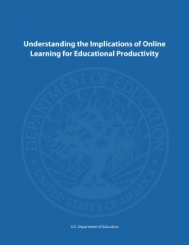Aug 2010 - SRI International
Aug 2010 - SRI International
Aug 2010 - SRI International
You also want an ePaper? Increase the reach of your titles
YUMPU automatically turns print PDFs into web optimized ePapers that Google loves.
<strong>SRI</strong> Alumni Association Newsletter • <strong>Aug</strong>ust <strong>2010</strong><br />
9<br />
HISTORY CORNER (Continued)<br />
Brazil. All the sessions were ably led by Joe, who had an<br />
unusual knack for patiently drawing participants to novel<br />
ideas or positions. That was, after all, the sometimes elusive<br />
but always sought-after goal.<br />
The thesis of the seminars was that companies should be<br />
organized to foster innovation and that efforts to instill it<br />
should involve senior management. We discussed such<br />
topics as<br />
• The creative process<br />
• Recognizing the traits of creative people<br />
• Management’s role in establishing a creative climate<br />
• Factors that initiate creativity and stifle it (i.e., bonds<br />
and barriers)<br />
• How to organize for creativity as part of a company’s<br />
planning process<br />
• Tools for generating ideas (besides brainstorming,<br />
such tools as bionics, synectics [the gathering of<br />
diverse parts into a whole that is greater than the sum<br />
of the parts], design trees, hypothetical scenarios, and<br />
many more)<br />
• Using such management concepts for fostering<br />
creativity as using product champions, creative<br />
partnerships, and “bridge people”; asking “demon<br />
questions”; and avoiding “idea killers.”<br />
Idea killers were important and their danger a cautionary<br />
preamble to every exploratory discussion. “That’s beyond<br />
our responsibility,” “It’s against company policy,” “It was<br />
tried years ago,” “It’s not new,” “It’s great but ahead of its<br />
time,” and the universal bad guy, silence, were some of the<br />
thought terminators we strove to avoid.<br />
Partly from insight but predominantly from experience,<br />
the program adopted techniques that led each project into<br />
the kind of exploratory atmosphere most conducive to<br />
innovation. Other linchpins of the process were captured in<br />
a book by Barry Minkin, one of Joe’s collaborators.* Among<br />
those tenets were that advance preparation is necessary;<br />
diverse parts of the organization, including managers, should<br />
be involved; smart, creative people from other disciplines<br />
help avoid channelization; a relaxed, informal environment<br />
for the sessions is essential; and a focused but stimulating<br />
direction, laced with humor, should be fostered to avoid<br />
the fatigue and low yield of free-floating, unstructured<br />
brainstorming.<br />
Birth of the Innovation Search<br />
The use of these techniques in short executive seminars led<br />
to a second program, the Innovation Search. This program<br />
concentrated more on projects for industrial clients, projects<br />
that would help them find new or extended uses for their<br />
existing products, services, technologies, or other strengths.<br />
These sessions lasted much longer and were conducted both<br />
at <strong>SRI</strong> and on clients’ premises. The searches included the<br />
top scientists and marketing staff from the client companies.<br />
In many cases, this process brought people from inside<br />
the company together for the first time, and the resulting<br />
dialogue often produced some unusually rewarding<br />
consequences.<br />
For the Innovation Searches, we chose participants from<br />
myriad parts of <strong>SRI</strong> to help think of new ideas for the<br />
companies, using the techniques from the Management<br />
of Innovation seminar. An important factor was not only<br />
choosing participants who were familiar with a client’s<br />
technologies under study, but choosing <strong>SRI</strong> “bridge people”<br />
from fields other than the client’s technologies. These bridge<br />
people could envision new opportunities based on ideas or<br />
areas of technology that the client didn’t possess and therefore<br />
couldn’t easily foresee. Some of the <strong>SRI</strong> participants who<br />
come to mind are Dick Knock with electronic and economics<br />
expertise; Fred Weil in metallurgy and economics; and<br />
Charlie Rosen, Hew Crane, Ron Swidler, Tom Parks, and<br />
Gerry Andeen with expertise in so many areas. Others too<br />
numerous to mention (and remember) participated as well.<br />
Dick Knock recalls that Ron Swidler held the record among<br />
<strong>SRI</strong> staff by participating in 22 searches!<br />
By the end of the week-long session, the result was a long list<br />
Joe McPherson (center) with Barry Minkin (left) at a session of new ideas and concepts for the client. The list was then<br />
in Venezuela in 1977 that concerned oil production<br />
and came on the heels of the government’s nationalizing<br />
a Dutch oil company operating there. *Barry Howard Minkin, Econoquake, Prentice Hall, 1993.
















